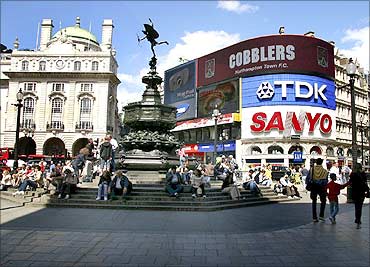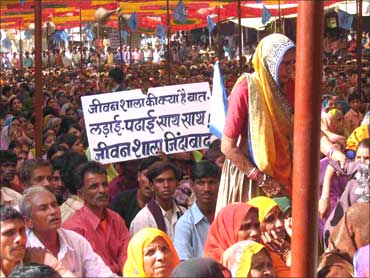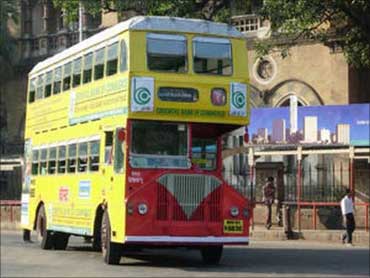 | « Back to article | Print this article |
Urban tsunami: India's big challenge
Since 70-80 per cent of the urban India that is going to be there is yet to be built, with good sense it can be built right, says Subir Roy.
That an urban tsunami is going to hit India (it has already begun doing so) is well known. In 20 years, by 2030, the country must make room for 250 million more urban-dwellers - the equivalent of 10 new Mumbais.
But the existing urban space is rapidly declining, the quality of life in Indian cities is among the worst in the world. The country is not equipped to tackle the urban challenge already there, not to speak of the one that's coming.
Urban tsunami: India's big challenge
But the challenge can be countered and overcome. A number of cities across the world have rescued themselves - Chicago, Barcelona, London - and it does not take a generation to do so. Plus, a consensus of sorts is emerging on how to do it.
Many of the concerns of civil society groups that are traumatised by city administrations cutting down trees to widen roads to make way for more and more private cars which keep raising pollution levels have been addressed in a detailed recent study by the consultancy McKinsey's global institute.
Of course, "sustainable" development does not figure upfront in the study but is there as an appendix.
Urban tsunami: India's big challenge
More importantly, the key solutions offered are in line with what have been widely discussed. So, with corporate wisdom and civil society seeing even partially eye to eye, the battle for minds is being won.
It is now up to civil society to keep shouting, get itself organised, and cause a dozen or more Janaagrahas to come up all over the country to take forward ward-level citizens' participation in urban decision-making.
The Indian middle class, which has difficulty in going out and voting, has to now take up ownership of its own habitat and future.
Since 70-80 per cent of the urban India that is going to be there is yet to be built, with good sense it can be built right and not need enormous effort later to address legacy problems. And since 75 per cent of urban-dwellers earn on average Rs 80 a day, they have to be the focus for devising solutions.
Urban tsunami: India's big challenge
But the daunting thought is that the bill for a habitable urban India is going to be phenomenal. India will need to spend $1.2 trillion (that is about its current income, GDP, for the whole year) in 2008 dollars towards urban capital expenditure. (Operating expenses will add another trillion.)
This works out to $134 per capita per year on capital expenditure till 2030, when current spending is $17. So, capital spending alone has to go up by nearly eight times
The urban economy will generate 85 per cent of the country's tax revenues. Also, according to current reckoning, cities will create 70 per cent or 120 million new jobs till 2030, compared to 50 million by non-urban areas.
And city jobs are nearly twice as productive as rural jobs. So, part of the money to redo cities right has to come from the country's tax pool. But this has to be through formula-based transfers, not ad hoc grants when the state government pleases.
Urban tsunami: India's big challenge
The 13th Finance Commission has already recommended transfer of Rs 4,700 crore (Rs 47 billion) in annual grants. The next one can recommend transfer of a part of the GST, a consumption-based tax suited to direct allocation.
But a good part of urban renewal funding can and should come from revenue earnings by urban local bodies themselves (Tier I and II cities can generate 80-85 per cent of their funding) through land monetising, levy of appropriate property taxes and user charges, borrowing and public-private partnerships.
But the key point is that urban local bodies simply do not have the leaders and administrative structure to deliver this. If by 2030 the largest Indian metropolitan clusters will have populations equal to that of many countries, then it stands to reason that they have to have political and administrative capabilities good enough to run a country.
Urban tsunami: India's big challenge
What you need is directly elected mayors, at least at the metropolitan level, helped by a dedicated administrative cadre and professional managers (as in BEST in Mumbai) to deliver. For that, there has to be careful planning.
A metropolitan planning setup has to include the peripheral areas of a city so that they are brought under planned development which makes for proper land use and aids the process of land monetisation.
India must also specifically incorporate sustainability objectives in its urban planning. The McKinsey study examines the key issue of greenhouse gas emissions. The first need is to set targets, say, bring down emission levels by 28 per cent by 2030 from what they were in 2005.
Urban tsunami: India's big challenge
India can meet this target by doing the following: reduce vehicle usage through public transport, improve vehicle fuel efficiency, increase use of electric two-wheelers in urban areas, build energy-efficient buildings with better insulation so that air-conditioning needs are lower, shift to solar-powered LED street lighting and - this is revolutionary - so design energy-efficient dense clusters (Indian cities are already dense but mostly unplanned urban sprawls) that more people can walk to work. What will we do with our Nanos then!
The point is, the debate is partly over. We are all agreed on a whole lot of things that make for sustainable urban development. So, let's try to educate the senior bureaucracy and the ministers.







